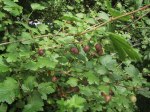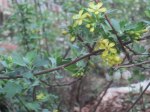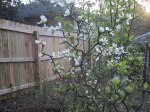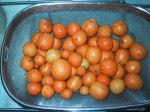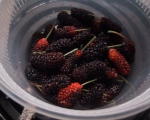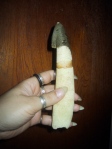Filed under: Uncategorized
Ok, so it is not officially summer. I consider it summer when I can’t go outside and enjoy myself because of the heat. So by that measure I guess that the season started a week or two ago. Even the mornings now are oppressive. The air is wet but no rain is to be found. Of course if I do get out for any period of time I have to bath in DEET to get through the swarms. I guess it could be worse though.
Anyway, blueberry season is here. I love going out and picking a few blueberries and mulberries for my morning granola. The blueberries are always dependable and tasty. These are a must for anyone who has an edible landscape. A few bushes can give you enough to add flavor to anything you cooking and last weeks if you get the right varieties. The wild mulberries were extremely heavy this year. I got caught up in other stuff and didn’t enjoy the free bounty. I should have some old sheets handy. Next year I will have some and hope harvest some for wine, jams or even a pie. Mine in the yard are still a bit small for such a show. The bigger ones are Illinois Everbearing, so I will get a tastier than usual, though a smaller harvest for next 2 months.
A very pleasant surprise this year has been the currants and gooseberries. That right, I said gooseberries in Atlanta. These northern fruit have been fruiting pretty heavy this year. The previous year, they would fall out before getting ripe, but I don’t know it is because I sprinkled a bit of wood ash around them last winter or was the long cold we had this year. I actually don’t know when these are ripe I don’t remember if they are supposed to turn dark purple or a lighter shade. They seem to be still holding to the bush as if they don’t want to be picked yet, so I will leave most of them on for right now. I might give them another week. I hope the birds don’t find ten before then. I can tell you the thorns are murder, you can’t pick them fast, and you will need a good pair of gloves. The currants on the other hand, are easily picked but are small. They are doing well too. I got a small crop from them, but I might be able to make a pint or half a pint of jam. The currants are champagne currants – they are white with pick blush. I had forgot about that, and was waiting for them to turn red. Both currants and Gooseberries can do ok here, but you really need a little evening shade, and I think you may need to lime the soil a little more than usual. Another current that is well worth mentioning is call Clove Currant or Buffalo Currant. They are native to northern areas, but seem to do well here. The flowers are showy and smell of cloves. I think these are more adaptable than other currant and gooseberries. They seem to be ok with more sun and heat of the south. The leaf and fruit is the size and shape of a gooseberry with may more of a black currant flavor. I cant say I have tasted a lot of each, so it hard for me to describe the favor. The fruit is almost jet back when ripe. There are no named varieties of this fruit, which are a shame; I would like to see these planted developed more.
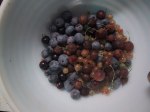
Sample of blueberries (blue), clove currants (black) champagne currants (pink) and Gooseberries (burgandy)
Filed under: Uncategorized
I have beautiful mature “Stella” sweet cherry tree next to the house in my front yard. This year started out as a great year for it. It burst out with a plethora of small white flowers that made the bees work overtime with their nectar collection. The tree was more white than green as the leaves were still young small. Surprisingly the honeybees were not doing most of the work as I expected. In fact,my friends were no were to be found most of this season. These pollinators were some other bees that I could identify as well as the mammoth carpenter bees. As the blooms faded, petals began to blow across my yard, like sprinkles of snow or like some scene out of Japanese romantic film – laying a thin carpet of white. The fruits grew fast and I could see that this would be the biggest crop of cherries that I have had yet. This is surprising though the tree is self fertile, I thought I would still always get a small crop without a pollinator. I should say that this tree does bloom almost the same time as my bush cherries. I imagine they could pollinate the tree cherries but I don’t know that for sure. A few cherries were dropping, for some odd reason I could not understand. I dismissed it as its own way of thinning. There were so many, the few that dropped was not a worry to me. I would have a bushel or more to contend with. I needed to be ready.
As I got busier at work with the semester approaching as end. I didn’t do my daily walk in the yard. I simply forgot about a lot of stuff and it showed. The grass grew tall weeds were everywhere. The worst of all the sweet cherry was losing its fruits. Both birds and Brown Rot were ravaging the pretty red globes that were weighing the tree limbs down. My neglects showed and my heart sank. I tried to spray some sulfur to stop the fungus from spreading. The birds were annoying with their picking one side of the fruit an leaving rest to rot, but the main worry was the Brown rot. It was everywhere. I have always had a little problem with this before, but it was never this bad, my attempted at spraying were too little to late. The damage was everywhere and there were hardly a perfect fruit to be found.
About this time I was planning to have pictures of me in the yard with this overloaded tree – that by the way is not supposed to produce here – like all those pictures of state fair champions with their head big and chest out posing by their champion sized pumpkin or steer. The pride that I had before was shot.
The really curious thing about it is that this cherry ripen earlier that expected. Usually my bush cherries that are now in full ripeness are usually the first to come in. This is unusually best because it distracts the birds while the Stella cherry is ripening. There is always enough bush cherries for me and bird, so I don’t mind them feeding on them. Plus the bush cherries are small enough to take the whole fruit so they don’t leave mess
Lastly. I think the bush cherries actually taste better. Now this may be sour grapes – or cherries in this case, (…. Sorry I could help it) but I tend to gravitate to the bush cherries. I have notices in the fridge for a bit they taste better, but off the tree they seem to be bit bland. Maybe this is just me. Others seem to like the tree cherry better than the bush cherries.
Plus, the bush cherries rarely have any problems with fungus – only when we get days of rain when it is ripe.
Dare I say I like Nanking cherries better than Stella??
So what’s the next step…what did I learn form this? No I wont cut down the tree. The tree is gorgeous …before during and after fruiting. I actually want to try more cherries if I have the space. There are a few more bush cherries out there to look at, also I could graft a sour cherry like Montrancy or Northstar on to Stella.
Most of all, I will need to bit the bullet and get out there early with the sprayer and get some sulfur up in that tree. I hope that will work for next year.
Filed under: Uncategorized
…. and with a vengeance!! Flowers are everywhere and bees are working overtime. “…sound and perfume swirl in the evening air.” (Debussy via Art of Noise). My Nanking cherries and Hall’s Hardy Almond has bloomed and past; now the Stella Cherry, Blueberries, Goumi, Currants, Hardy Citrus and Crabapple. Even the ones that are not blooming are waking up sooner than expected.
Everything is off to a good start. We had some good soaking rains last month, but recently it has been dry. This means the flowers are strong and I hope the low humidity will keep disease pressures at bay. Also these bright warm days we have had make for perfect pollination weather. Swarms of bees are in my yard all happy and working like there is no tomorrow. I have seen many kinds of bees and wasps of the native bees are rare in my yard.
Some of the star pollinators are the Carpenter bees. I know there is a love hate relationship between these monsters of bees. Any exposed wood becomes a potential home for them to bore out holes. Luckily my eaves have not seen any damage, but I do have to watch for them in the green house. The males will startle many people as they try to defend a certain territory, but they do not really care about people they just to make sure you not a another bee. After flying around your head a few time the go back to their post till they find another male bee to challenge. I have seen some all out bee battles I my yard too. I also get a number bumblebees in the yard. Often confused with Carpenter bees, they tend to be a little smaller with more fuzzy abdomens. I get plenty of mason bees. They are small bees with a bulbous abdomen that is black with slight blue iridescence. Many would mistake them for a fly at first. Their buzzing sound is very similar. These may be progeny of the ones a bought in a kit two years ago, that I keep a “condo unit” for in the back yard. In the same units I get leaf cutter bees – that seem to use thin strips of grass for their nest, and Giant Resin Bees that are near the size of carpenter bees. Some bees I don’t see often have been showing up regularly this year. I saw few green sweat bees and a huge swarm of what I thin k are yellow-faced bees doing the work that the honeybees should be doing.
Oddly enough, I have not seen the ubiquitous honeybee recently. When the Nanking cherries first came out, there were plenty of them – they love this particular bush for there is nothing else blooming at the time they wake up. I am sure they are hungry after winter for new forage. But now I have not seen even one in the last week or two. Did I say something wrong? Could they have found more tasty nectar somewhere else? Seems very odd. I like honey making friends.
My flowers are still pollinated though. There was once I was worried about pollination, but the quantity of bees I see all over the yard even with out the honey bees have assured me that the flowers are visited many times a day.
Filed under: Uncategorized
I friend of mine in a side bar note told me that this fruit nursery that I was vaguely familiar with is starting to sell scion wood from some of their stock. I guess I didnt pay attention to it at first, cause I looked on web site at a few selection and then moved on. I didn’t hit me till later that THIS WAS MAJOR! Fruit trees can be expensive if you trying to utilize a large space as a home grower, so usually people just buy a few trees a year. Grafting becomes away that one share material with friends and build a community of fellow orchardist, but if you in area that doenst have a scion exchange group or know few fruit growers, grafting may just end up being more of an academic exercise unless you want to propagate more of what you have.
Now I understand for the nursery that the profit margin on scion wood may be very little and you are catering to a very niche group of amateur fruit growers, but I can say for me this is pretty big news. People around here complain about mulberry weed trees in their yard. I feel for them if you have bland tasting wild mulberries around taking up space, but now I can get 5 different named variety cutting for under $20 and turn those seedlings to very desirable trees. So this spring I will be very busy. I am sure I will graft the while spring break this year with mulberries, pawpaw and what ever else come to mind to try.
…now if I could find something to graft on to Chinese privet!
Filed under: Uncategorized
A wonderful gift from my sister this Thanksgiving were some colorful kumquats. I had never seen ones like this. The fruits were variegated. They like similar to the variegated Spanish limes you see sold at Home Depot sometimes, but these were orange. I had to do a little Googling to find out what they were because I did not think they were pure kumquats. The current thought is that these are ‘Centennial’ variegated kumquats. I thought maybe a weird hybrid like Orangequats or Citrangequats. They were a lot larger that one in the stores nor did they have sweet tasting skin/peel, but extremely juicy unlike most kumquats. The fruit did have a sour/acidic tangerine favor. It was just a bit to sour to eat on its own (though I could get used to it), but I could see something being made with them. She made nice tasting meringue pie with them for Thanksgiving and the year before she made some nice marmalade. Now I wish I got some more of that pie to take home with me.
This has got me thinking more about citrus I can put in my yard. There are not many citrus that will grow in north-central Georgia. Most that can grow here are not that tasty, but I have a few choice ones with some possibility (read ode to Thomasville.). I am sure there are others are out there that I haven’t tried yet. I have recently built a little plastic shelter on the side of my house for my citrus experiments. Its just a PVC structure that I can cover with some 6 mil clear plastic for the coldest nights. Once these trees get to a goods size I hope they wont need the plastic.
Today I cut these fruits up and plan to try some wine with what she gave me. I of course extracted the seeds to see is I can grow any to add to my collection. I don’t know how hardy it would be, but I always like to test things.
Filed under: Uncategorized
I know, its been a long time.. I have been busy with a lot of projects. I have even been in yard till recent. Fall is the time to work in the yard and plant new stuff.
I have been doing plenty of that.
Now the Pineapple Guavas are in ripening and falling off the bush. These are one of the best bushes to have in the front landscape. These are lovely evergreen bushes –Camilla like and care free. I don’t even feed mine. I do lay down leaf mulch and straw each year.
Each late spring, the bush is flushed with light purple fleshy flowers with red stamens. The flower petals are actually mildly sweet and minty if you choose to munch on some.
Around mid November you will get some green-yellow torpedo shaped fruit beginning to drop from the bush. This is one of the reasons I like to have brown mulch under the bush. If you have grass, you wont be able to find them easily. Oddly enough birds and squirrels don’t seem to bother them either (knock of wood – as saw one today that had been pecked at a bit by something). Every few days I will go outside to collect ones that have fallen. This will last for about 2 weeks or more. I will bring the bag of them in the kitchen and by the days end the are is filled with a sweet fragrance not to unlike Quince.
For your lack of care with this plant you still get large amount of fruit. With 2 large bushes I get a about a large grocery bag full. of fruit. You cant beat that!!
It is about time to start sorting them out now. The medium to small or bruised ones I will set aside for wine. The others I will eat fresh, share with friends or try a recipe.
If any goes bad, I don’t waste those either. I wait till thy get real sour a mushy and strain the seeds out for planting new ones. The seed are tiny and difficult work with (about the size kiwi seeds), but readily germinate.
Today was great day for picking it was sunny, but cool. For some good reason this year I got some really big ones! I hope this trend continues. The bees were buzzing around the Loquat tree with great fervor and I was on my back and side in the grass picking up these sweet aromatic gems. I felt like an XTC song made flesh.
Filed under: Uncategorized
My Mulberries are coming in nicely this year. I get enough to add to my breakfast cereal. I guess I could save them up and make a tart or small pie, but often I just like then off the tree. The birds seem to like them even more than me and get most of them, but I still get a share.
I often wonder if most people have had a good mulberry before. I had a number of people ask me what they were. Some people call them tree blackberries (which I find amusing). The people I do meet (who are not fruit growers) that have tried a mulberry are only familiar with a wild insipid one they may find in the yard. “It’s a big fast growing weed tree” the say, “You got one, you got them everywhere”. “ It stains the driveway and my dog’s fur”. Yes, it will do all of that; not that I was really concerned with the color of my driveway there are plenty of things form other plant material and my car that I do a better job of that (but that’s just me). The results of this is most are chopped down before given a chance to prove them selves. I just think people are missing a good opportunity here to explore. There are some wonderful tasting mulberries out there that are wild and unfound. The trees are “no-care” and very productive. I guess that what makes them weeds. Don’t get me wrong, there are many bad ones out there, in fact most are. A bad mulberry should be chopped down (or used as a rootstock for a good one), but good one in the right place deserves to be saved and passed on. There are cultivated one out there in the nursery trade, not to many compared to the common fruits, but there are a selection – there need to be more though. That selected variety could be growing in the back of your yard or right now. These this the perfect place to go exploring for them.
One of the reasons that mulberries are so prolific here is one of the first Georgia crops were mulberries trees. The effort was to try to compete with the Chinese silk trade. The Chinese were very secretive of their operations. Any spies or suspected spies no matter if local or forign born were killed on sight, so the Georgians had to try it by hit-and-miss. They first had the wrong type of mulberry, then they discovered the worms didn’t like the environment as much, they could not get the operation going on a level to be profitable, so they gave up. One of the results is that we have a native and non-native mulberry here that hybridizes easily. Don’t ask me which is which, I get confused. I even here different rendition of the silk story, but we have a large selection of mulberries as a result. There are actually thought to be something like 5 different specie (maybe including sub specie) of mulberries. The gem of all (for taste) seems to be the Morus nigra Black mulberry. For some reason it doesn’t seem to grow well in the east. One expert friend of mine seems to think it is a disease issue. I have tasted some of those and they are wonderful, but we do have respectable ones here.
But I degrees…
The point I was trying to make is to keep you eyes (and mouth) open and share what you have. More real gems are out there, and each has their own character. Not much research has been done on the fruit that I know of, but I have to wonder if there a number of nutritional components contained in the fruit. The fruit doesn’t seem to suffer form fungal problems like other fruits here even in the damp, also the staining aspect of the fruit may suggest high antioxidant levels. This is a shot in the dark, based in a chemist friend of mine but I cant imagine there is anything that harmful.
So you ask, why out of all the bad trees out there you think someone will find a keeper, because it happen to me TWICE. I found 2 trees, though I have yet to say are nursery trade quality, I thought were a worth keeping. The story of one is written about previously (in a most unusual location) and the other one was at a friend’s house. A tree next to her house that she was sure about and was going to cut it down, till I tasted the fruit. I asked her to try it, and she decided just to trim it instead. The family added the berries to their cereal there on out. I took a cutting and gated it to a wild seedling and it is now growing in my yard.
Of course new trees will pop up form time to time as birds art the fruit and poop – it wont be an invasion. Also the valued tree may be against the house a bad place. If not pruned, they will get big an out of control. Just root a piece a move it somewhere else or give cutting to someone who really wants it.
Once the tree is gone its gone.
Filed under: Uncategorized
Here is little known fruit (in this area at least) that need more attention. Its one of the few temperate evergreen fruit bushes around, so it is perfect for a single bush or a wind break. The another common name for it is Pineapple Guava. It is not a true Guava that you would see in tropical markets, but is still part of the myrtle family. Dont let the name fool you it is a cold hardy bush. I have never seen any real damage to it around my house and I know some people are growing them north Georgia. Some leaves will burn on the end when we go down to single digits, but I always get a new flush of leaves in the spring. The bush can be pruned to a short hedge or trimmed to a small tree. The leaves are similar to a Camellia but have a frosted look to them. The flowers have white-lavender fleshy petals and red stamens and yellow tips. The petals are even slightly sweet and minty flavored. The fruit looks like small aromatic green torpedoes with a taste that is sweetly acid. Some say it is a mix of strawberry and pineapple, but I think it has taste all its own. It is a great fruit for salads and salsa or just fresh. Some people eat just the inside witch is more sweet, others will eat the skin and all which have a more sharp flavor. The seeds are tiny and unoticable like kiwis.
It is a very low care bush. I have never done anything to it. I will occasionally take brush an dab the flowers, so I am sure I get the best pollination, but it may not be necessary. You will need two bushes to get fruit. I have never sprayed, watered or even covered the bush, and I am always rewarded with a few bushels of fruit every year -even during the drought years (the fruit were just smaller). The squirrels or birds dont seem to like it. I dont know if they even know it is there. The fruit stays green even when it is most ripe and at a distance may be hard to see on the bush. You know it is ripe when the fruit falls to the ground. This happens around late October early November here.
I am thinking about them now because I just picked a bunch of flower petels to make mild flavored wine…so actually you could say you get two crops out of the bush! I have made a very distinctive flavored wine out of the fruit as well lst year. This has to be one of the top fruit trees in the yard.
Filed under: Uncategorized
Sorry for the vulgar title, but seems appropriate for what is happening in the yard. I saw these things last year in the yard for the first time and was rather fascinated by them. This year they came back in an even wider area. after a little research, I discovered that these are Stinkhorn mushrooms. They are not a sign of anything bad, but they are alarming in the shape, color (in my case) and smell. The on shown here is from recent mushroom walk. The one in my yard is a little smaller and is red in color. The smell is maybe one of somewhere between stinky cheese and sweaty underwear. 🙂 …but yet kinda yeasty
I was told that it is eaten in Asia. I don’t think I will try it this time, but I do plan on examining it further. I have it in the house right now and the smell lingers everywhere.
Maybe I will light a few matches.
Filed under: Uncategorized
This is another old one of last year that I put up because of some interest in citrus growing in Atlanta.
though my love has cooled just bit, because a few minor problems I have had in recent years with it. It is still a great tree to try out.
————————
I love Thomasvilles!
I know all of you are saying WTF!
So let me back up.
I got some fruit seedlings from the bamboo garden in Savannah, GA. of a hardy citrus called Thomasville Citrangequate. This was from a gorgeous 30+ year old tree with deadly 4 inch spikes surrounding the base. So yes, you can grow citrus in Atlanta. The great thing about the tree is that it is VERY precocious. It started fruiting in its fourth year from seed. Thats good for most trees, but great for citrus. Most dont get going till their tenth.
But why do I love this tree so much. Well, maybe it was partly due to the wait, but also the look, taste and experience of eating this fruit is very special. The fruit is teardrop shaped and can range in size from a medium size fig to a good sized plum. My first crop was flawless orange yellow which gave a nice contrast to very dark green leaves. Because of it Kumquat heritage, there is not bitter pith to the fruit. In fact, the skin is mildly sweet, which contrast nicely to the sharp sourness of the pulp. The pulp tastes like a grapefruit to me. The lack or pith means you eat the fruit WHOLE! There may be a 3-5 seeds in there (which you will easily find and save!) I am the type that eats a good grapefruit without sugar( if I can peel the pith and membrane off). The skin also gives you that little tingle on your tongue and lips that Grapefruit rind give if you ever had candy from the rind. So this gave a joyous experience eating the fruit. Unlike most kumquats the the fruit was juicy and big enough to take few bites from just one.
Now in the off chance you have heard of this fruit, you may have also heard that it has the “Poncirus wang” taste to it (The very hardy Poncirus being another part of its heritage). That may be true for some, but I can say I have never tasted it mine. I tend to believe that there may be a 2 or more races of these Thomasvilles and I happened to get the one that dosent have this taste, or maybe I and my friend just dont taste it. I can say I am a “super taster” so I dont know.
My tree is growing fast, I cant wait till I get enough of these little gems to share with people and to make things with them. I cant say this is my favorite tree in the yard yet. I is usually is what ever I am harvesting at the time, but can say I will really look forward to tasting the fruit and propagating this tree next year!
PS: another surprise for this year have been my Ichang lemon that has leaves that smell like the more tropical Kiefer Lime!
